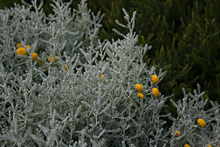Gray saint herb
| Gray saint herb | ||||||||||||
|---|---|---|---|---|---|---|---|---|---|---|---|---|

Gray saint herb ( Santolina chamaecyparissus ) |
||||||||||||
| Systematics | ||||||||||||
|
||||||||||||
| Scientific name | ||||||||||||
| Santolina chamaecyparissus | ||||||||||||
| L. |

The Gray Heiligenkraut ( Santolina chamaecyparissus ) is a plant from the genus Heiligenkraut ( Santolina ) in the family of Compositae (Asteraceae).
features
The Graue Heiligenkraut is an evergreen dwarf shrub that reaches heights of 15 to 50 centimeters. The stems are branched and (6) 8 to 15 millimeters in diameter. The leaves are tomentose and very aromatic, the lower ones are 2 to 4 centimeters long, the upper ones 1 to 3 centimeters long. The leaves have 9 to 14 sections on each side. These are rolled up and 0.5 to 2 millimeters long. The flower heads are usually arranged in several on the stems. The flowers are yellow.
Flowering time is from July to August.
The number of chromosomes is 2n = 18, less often 36 or approx. 45.
Occurrence
The gray saint herb is widely naturalized in the western and central Mediterranean area , the exact origin is unclear. This pentaploid species is possibly of hybridogenic origin. It grows on disturbed maquis and garrigues as well as ruderally. The original distribution area of the aggregate Santolina chamaecyparissus agg. includes Spain, France, Andorra, the Balearic Islands, Corsica, Italy, Croatia, Sardinia and Sicily.
use
The gray saint's herb is widespread in warm areas, otherwise rarely used as an ornamental plant for rock gardens, dry stone walls, stone beds and borders, as well as a structure plant, as a medicinal and scented plant and as a moth herb. The species has been in culture since at least 1539. There are few varieties, for example these are more compact. The hybrid Santolina × lindavica from Santolina chamaecyparissus and Santolina pinnata has been known since 1917 . It has blue-green leaves and yellowish flowers and mediates between the two parent species.
Synonyms
Synonyms for Santolina chamaecyparissus are:
- Santolina ericoides Poir. non hort.
- Santolina incana Lam.
literature
- Eckehart J. Jäger, Friedrich Ebel, Peter Hanelt, Gerd K. Müller (eds.): Rothmaler excursion flora from Germany. Volume 5: Herbaceous ornamental and useful plants . Spectrum Academic Publishing House, Berlin Heidelberg 2008, ISBN 978-3-8274-0918-8 .
Individual evidence
- ↑ Santolina chamaecyparissus at Tropicos.org. In: IPCN Chromosome Reports . Missouri Botanical Garden, St. Louis
- ↑ Werner Greuter (2006+): Compositae (pro parte majore). - In: W. Greuter & E. von Raab-Straube (eds.): Compositae. Euro + Med Plantbase - the information resource for Euro-Mediterranean plant diversity. Datasheet Santolina chamaecyparissus agg. In: Euro + Med Plantbase - the information resource for Euro-Mediterranean plant diversity.
Web links
- Entry in Plants for a Future. (engl.)